Burial Basilica of St Denis Name Margaret Valois Role Queen of Navarre | Siblings Charles IX of France Mother Catherine de' Medici | |
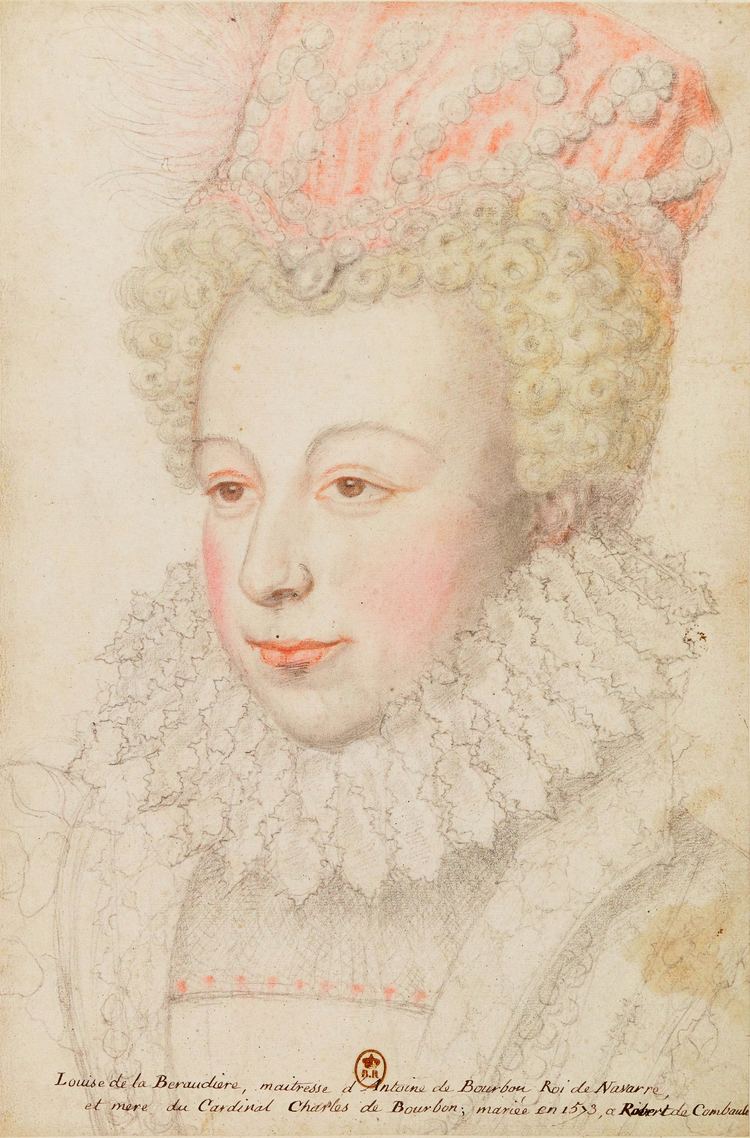 | ||
Tenure 2 August 1589 – 17 December 1599 Tenure 18 August 1572 – 17 December 1599 Born 14 May 1553Chateau de Saint-Germain-en-Laye ( 1553-05-14 ) Spouse Henry IV of France (m. 1572–1599) Parents Catherine de' Medici, Henry II of France Grandparents Claude of France, Francis I of France, Lorenzo de' Medici, Duke of Urbino, Madeleine de La Tour d'Auvergne Similar People Henry IV of France, Catherine de' Medici, Charles IX of France, Henry III of France, Henry II of France | ||
Margaret of valois
Margaret of Valois (French: Marguerite, 14 May 1553 – 27 March 1615) was a French princess of the Valois dynasty who became queen consort of Navarre and later also of France.
Contents
- Margaret of valois
- Margaret Of Valois
- Early life
- Marriage
- St Bartholomews Day massacre
- Malcontent conspiracy
- Diplomatic mission in Flanders
- Nrac
- Scandal in Paris
- Agen and Usson
- Last years
- Death
- In literature and fiction
- References
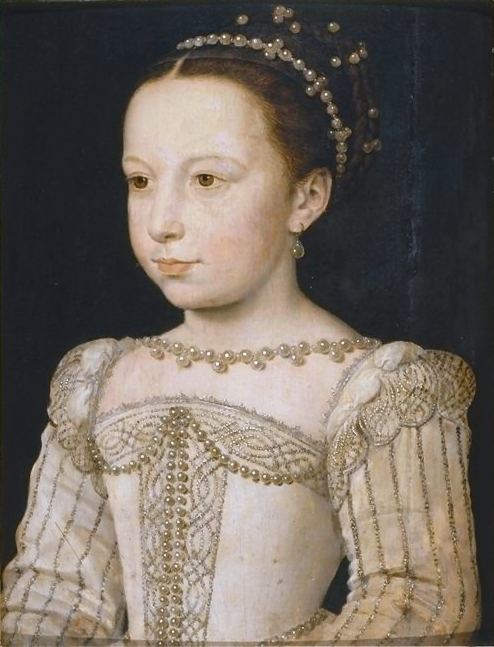
A daughter of King Henry II of France and Catherine de' Medici, Margaret was the sister of kings Francis II, Charles IX and Henry III, and of Elisabeth of Valois Queen of Spain, as well as Claude of Valois. Charles IX arranged for her to marry a distant cousin, King Henry III of Navarre, and she thus became Queen of Navarre in 1572. In 1589, after all her brothers had died leaving no sons, Margaret's husband, the senior-most agnatic heir to France (the "Prince du sang"), succeeded to the French throne as Henry IV, the first Bourbon King of France. She was indeed one of the most fashionable women of her time, and influenced many of Europe's royal courts with her clothing.
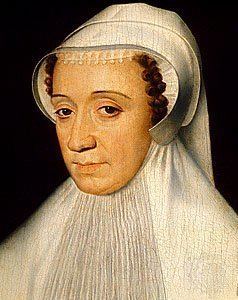
A queen of two kingdoms, Margaret was subjected to many political manipulations, including being held prisoner (albeit at a comfortable castle) by her own brother, Henry III of France, for many years. While imprisoned, she took advantage of the time to write her memoirs, which included a succession of stories relating to the disputes of her brothers Charles IX and Henry III with her husband. The memoirs were published posthumously in 1628.

She has been a victim of a historiographic tradition that has demolished the importance of her actions in the political sphere of the era, to reinforce the dynastic transition from the Valois to the Bourbon, giving credit to libel and slander circulated on her account and created and handed down through the centuries the myth of beautiful woman, cultured, nymphomaniac and incestuous. This legend has crystallized around the famous nickname Queen Margot (La Reine Margot), invented by Alexandre Dumas, père.
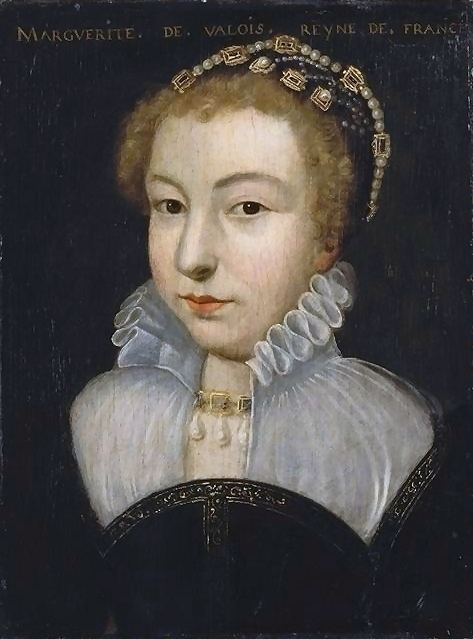
Her life has inspired a variety of stories over the centuries, beginning with William Shakespeare's early comedy Love's Labour's Lost, which was in fact written within her lifetime, to Alexandre Dumas, père's 1845 novel La Reine Margot; to a 1994 movie La Reine Margot.
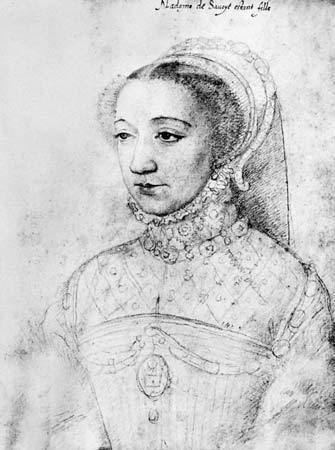
Margaret Of Valois
Early life
Margaret of Valois was born on May 14, 1553, at the royal Château de Saint-Germain-en-Laye, the seventh child and third daughter of Henry II and Catherine de' Medici. Three of her brothers would become kings of France: Francis II, Charles IX and Henry III. Her sister, Elisabeth of Valois, would become the third wife of King Philip II of Spain.
Her childhood was spent in the French royal nursery in the royal Château de Saint-Germain-en-Laye with her sisters Elisabeth and Claude, under the care of Charlotte de Vienne, baronne de Courton "a wise and virtuous lady greatly attached to the Catholic religion". After her sisters' wedding, Margaret grew up in the Château d'Amboise with her brothers Henri and Francis.
At the French court, she studied grammar, classics, history and Holy Scripture. Margaret learned to speak Italian, Spanish, Latin and Greek in addition to speaking her native French. She was competent also in prose, poetry, horsemanship and dance. She traveled with her family and the court in the grand tour of France (1564-1566). During this period, Margaret had direct experience of the dangerous and complex political situation in France and she learned from her mother the art of political mediation.
In 1565, Catherine met with Philip II's chief minister Duke of Alba at Bayonne in hopes of arranging a marriage between Margaret and Philip's son Don Carlos. However, Alba refused any consideration of a dynastic marriage. Even the marriage negotiations with Sebastian of Portugal and Archduke Rudolf did not succeed.
By 1570, Catherine de' Medici was seeking a marriage between Margaret and Henry of Navarra, a Huguenot (French Calvinist Protestant). It was hoped this union would reunite family ties, as the Bourbons were part of the French Royal family and the closest relatives to the reigning Valois branch, and create harmony between Catholics and the Protestant Huguenots.
However, Margaret was secretly involved with Henry of Guise, the son of the late Duke of Guise. Some historians have hinted that the duke of Guise was a Margaret's lover, but nothing authorises this theory. When Catherine found this out, she had her daughter brought from her bed. Catherine and the king then beat her and sent Henry of Guise from court.
On 11 April 1572, Margaret was engaged with Henry of Navarra. In one of her letters to Henry, his mother the queen of Navarre Jeanne d'Albret, wrote about Margaret: "she has frankly owned to me the favourable impression which she has formed of you. With her beauty and wit, she exercises a great influence over the Queen-Mother and the King, and Messieurs her younger brothers".
Marriage
The marriage of the 19-year-old Margaret to Henry, who had become King of Navarre upon the death of his mother, Jeanne d'Albret, took place on 18 August 1572 at Notre Dame cathedral in Paris. The marriage between a Roman Catholic and a Huguenot was controversial. Pope Gregory XIII refused to grant a dispensation for the wedding, and the different faiths of the bridal couple made for an unusual wedding service. The King of Navarre had to remain outside the cathedral during the mass, where his place was taken by Margaret's brother Duke of Anjou.
François Eudes de Mézeray, a 17th century historian, invented the legend that Margaret was forced to marry the King of Navarre with a little push at the back of her head by her brother Charles IX. This is one of the anecdotes that created the myth of the "Reine Margot". Margaret wrote in her Memoirs:
I was set out in the most royal manner. I wore a crown on my head with the coët, or regal close gown of ermine, and I blazed in diamonds. My blue-coloured robe had a train t it of four ells in length, which was supported by three princesses. A platform had been raised, some height from the groud, which led from the Bishop's palace to the Church of Notre-Dame. it was huge with cloth of gold; and below it stood the people in throngs to view the procession, stifling with heat. we were received at the church door by the Cardinal de Bourbon, who officiated for that day, and pronounced the nuptial benediction. After this we proceeded on the same platform to the tribune which separates the nave from the choir, where was a double staircase, one leading into the choir, the other through the nave to the church door. the King of Navarre passed by the latter and went out of church.
St Bartholomew's Day massacre
Just six days after the wedding, on St Bartholomew's Day, Roman Catholic factions instigated a targeted group of assassinations, followed by a wave of mob violence, both directed against the Huguenots.
Traditionally believed to have been instigated by Catherine de' Medici, the marriage was an occasion on which many of the most wealthy and prominent Huguenots had gathered in largely-Catholic Paris. That took place during the period 1562 to 1598, known as the French Wars of Religion, with factional disputes between the aristocratic houses of France, such as the House of Bourbon and the House of Guise (Lorraine). Henry of Navarre had to feign conversion to Catholicism.
In her Memoirs Margaret remembered that she saved the lives of several prominent Protestants, during the massacre, by keeping them in her rooms and refusing to admit the assassins. Her eye-witness about the massacre in Memoirs is the only coming from the royal family. These facts inspired Alexandre Dumas for his famous novel La Reine Margot (1845).
After St Bartholomew's Day, Catherine de' Medici proposed to Margaret that the marriage be annulled, but she replied that this was impossible because she had already had sexual relations with Henry and was "in every sense" his wife. Later she wrote in her Memoirs: "I suspected the design of separating me from my husband was in order to work some mischief against him".
In the libelle Le Réveil-matin des Français wrote by an anonymous Huguenot author in 1574 against the royal family, Margaret was accused for the first time of incest with her brother Henry. This slander is another of the anecdotes about the myth of the "Reine Margot".
Malcontent conspiracy
In 1573, the Charles IX's fragile mental and physical constitution weakened drastically, but his natural heir, his brother Henry, who was in favor of a policy of firmness against the Protestants, was elected king of Poland. Moderate Catholic lords, called Malcontents, supported the project of raising the younger brother, Francis of Alençon, to the throne of France, in case of vacancy, deemed favorable to a confessional compromise in religious affairs. Allied to the Protestants, Malcontents put into practice several plots to seize power.
By an inclination for her two elder brothers, Margaret initially denounced this sling in which her husband was involved, but then changed her alliance in the hope of become an indispensable link between moderate Catholic supporters and her King of Navarre's Huguenot supporters.
In april 1574 the conspiracy was frustrated, the leaders of the plot were arrested and decapitated, one of them was Joseph Boniface de La Mole, pretended lover of Margaret. After the failure of the conspiracy, Francis and Henry were held prisoners at the Château de Vincennes. Margaret wrote a pleading for her husband, the Supporting Statement for Henry of Bourbon. She recorded in her Memoirs:
My husband, having no counsellor to assist him, desired me to draw up his defence in such a manner that he might not implicate any person, and, at the same time, clear my brother and himself from any criminality of conduct. With God's help I accomplished this task to his great satisfaction, and to the surprise of the commissioners, who did ot expect to find them so well prepared to justify themselves.
After Charles IX's death, at the accession of Henry III of France, Francis and Henry were left at liberty under surveillance at court, but the new king did not forgive Margaret for having betrayed him.
The relations of the Navarre couple deteriorate, Margaret did not get pregnant - for, if there had never been any question of love between the spouses, Henry continued his marital debt assiduously. But he had many mistresses and openly deceived Margaret with Charlotte de Sauve, member of Queen Mother's notorious "Flying Squadron". Charlotte also provoked a quarrel between Alençon and Navarre, both her lovers, whom Margaret was endeavoring to ally.
This episode relativizes the image of a couple multiplying certainly the infidelities but to the solid political alliance. In reality, Henry only approached his wife when it served her interests, but did not hesitate to abandon her in the opposite case. For her part, Margaret might have availed herself of the absence of jealousy of her husband to take a lover in the person of the famous Bussy d'Amboise.
Alençon and Navarre finally managed to escape, one in September 1575 and the other in 1576. Henry did not even warn his wife of his departure. Margaret finds herself recluse at the Louvre, guards at the doors of her room, for Henry III holds her as an accomplice. She wrote in her Memoirs:
Besides, I had found a secret pleasure, during my confinement, from the perusal of good books, to which I had given myself up with a delight I never before experienced. [...] My captivity and its consequent solitude afforded me the double advantage of exciting a passion for study, and an inclination for devotion, advantages I had never experienced during the vanities and splendour of my prosperity.
Alençon, who allied himself with the Huguenots, took up arms and refused to negotiate until his sister was captured. She is therefore released and assisted her mother in the peace talks. They led to a text extremely beneficial to the Protestants and to Alençon: the Edict of Beaulieu.
Henry of Navarre, who had once again converted to reform, sought to have Margaret joined him in his kingdom of Navarre. During this conflict, they reconciled to the point that she faithfully reports what she learns from the court. But Catherine de' Medici and Henri III refused a time to let her go, Margaret being likely to become a hostage in the hands of the Huguenots or to strengthen the alliance between Navarre and Alençon. Catherine is persuaded that Henry of Navarre is "recoverable" for the Catholic party and used her daughter as a bait to attract him to Paris.
Diplomatic mission in Flanders
In 1577, Margaret asked permission to go on a mission in the south of the Netherlands on behalf of her younger brother Francis d'Alençon. The Flemings who had rebelled against Spanish rule in 1576 seemed willing to offer a throne to a foreign prince who was tolerant and willing to provide them with the diplomatic and military forces necessary to conquer their independence. Henry III accepted the proposal of his sister because he would finally release the inconvenient duke of Alençon.
On the pretext of a bath in Spa thermal waters, Margaret left Paris with her gorgeous court. She devoted two months to her mission: at every stage of the journey, during brilliant receptions, the queen of Navarre was entertained with gentlemen hostile to Spain and, while praising his brother, she tried to persuade them to join him. She also met the governor of the Netherlands, Don Juan of Austria, with whom he had a friendly meeting in Namur. Almost one quarter of her Memoirs are devoted to this mission. For Margaret, returning to France was dangerous with the risk that the Spanish would capture her.
At the end, despite the contacts Margaret had found, the duke d'Alençon was incapable of defeating the Spanish army.
Nérac
After reporting her mission to her younger brother, Margaret returned to the court. The fighting multiplies between Henry III's mignons and Alençon's supporters, in the forefront of which Bussy d'Amboise, a lover of Margaret. In 1578 Alençon asked to be absent. But Henry III saw in it the proof of his participation in a conspiracy: he had him arrested in the middle of the night, and kept him in his room, where Margaret joined him. As for Bussy, he is taken to the Bastille. A few days later, Francois fled again, thanks to a rope thrown out of his sister's window.
Shortly afterwards, Margaret, who denied any participation in this escape, finally got permission to join her husband. Catherine also saw the years pass and still has no heir. She hoped for a new wedding and invited her son-in-law to act as a good husband. Perhaps Henry III and the Queen mother also hoped that Margaret could play a conciliation role in the troubled provinces of South-West.
For her return with her husband, Margaret was accompanied by her mother and her chancellor, a renowned humanist, magistrate and poet, Guy Du Faur de Pibrac. This journey was an opportunity for entering the cities crossed, a way of forging closer ties with the reigning family. At the end of their journey, they finally found the King of Navarre. Catherine and her son-in-law agreed on the modalities of the execution of the last edict of pacification - the object of the Nérac conference in 1579 - then the Queen mother returned to Paris.
After her departure, the spouses stay briefly in Pau where Margaret suffered from the prohibition of Catholic worship. They then settled in Nérac, capital of the Albret (which was part of the kingdom of France and where the religious regulations intolerant in force in Béarn did not apply). Queen Margaret worked to create a refined court.
Margaret was indeed forming a true literary academy. Besides Agrippa d'Aubigné, Navarre's companion in arms, and Pibrac, the poet Saluste du Bartas or Montaigne frequented the court. Margaret had many exchanges with the author of the Essays.
The court of Nérac became especially famous for the amorous adventures that multiply there, to the point of having inspired Shakespeare's Love's Labour's Lost. Margaret was lent an affair with one of the most illustrious companions of her husband, the Vicomte de Turenne. Henry of Navarre, on his side, endeavored to conquer all the maids of honor who accompanied his wife.
Scandal in Paris
After an illness in 1582, Queen Margaret returned to the court of her brother, Henry III, in Paris. Her brother was soon scandalized by her reputation and behavior, and forced her to leave the court, even claiming that she had borne a bastard child by Jacques de Harlay. After long negotiations, she was allowed to return to her husband's court in Navarre, but she received an icy reception.
Agen and Usson
Determined to overcome her difficulties, argaret masterminded a coup d'état and seized power over Agen, one of her appanages. She spent several months of fortifying the city, but the citizens of Agen revolted against her, and she fled to the castle of Carlat with a lover called d'Aubiac. In october 1586, Margaret was imprisoned by her brother Henry III in the castle of Usson, in Puy-de-Dôme, Auvergne. D'Aubiac was executed, despite Catherine de' Medici's wish, in front of Margaret.
Queen Margaret spent eighteen years in the castel of Usson first as a state prisoner under her brother then a prisoner in exile under her husband who divorced her. During this time, Margaret wrote her Memoirs consisting of a succession of stories relating to the affairs of her brothers Charles IX and Henry III with her former husband Henry IV. The Memoirs were published posthumously in 1628.
In 1589, Henry, her husband, succeeded to the throne of France as Henry IV. He was, however, not accepted by most of the Catholic population until he converted four years later. Henry continued to keep mistresses, most notably Gabrielle d'Estrées from 1591 to 1599, who bore him four children. Negotiations to annul the marriage were entered in 1592 and concluded in 1599 with an agreement that allowed Margaret to maintain the title of queen.
Last years
She settled her household on the Left Bank of the Seine, in the Hostel de la Reyne Margueritte that is illustrated in Merian's 1615 plan of Paris (illustration); the hostel was built for her to designs by Jean Bullant in 1609. It was eventually demolished and partially replaced in 1640 by the Hôtel de La Rochefoucauld.
Reconciled to her former husband and his second wife, Marie de' Medici, Queen Margaret returned to Paris and established herself as a mentor of the arts and benefactress of the poor. She often helped plan events at court and nurtured the children of Henry IV and Marie.
Death
Margaret died in her Hostel de la Reyne Marguerite, on 27 March 1615, and was buried in the funerary chapel of the Valois in the Basilica of St. Denis. Her casket has disappeared and it is not known whether it was removed and transferred when work was done at the chapel, or destroyed during the French Revolution.
In literature and fiction
The 1845 novel of Alexandre Dumas, père, La Reine Margot, is a fictionalised account of the events surrounding Margaret's marriage to Henry of Navarre.
The novel was adapted into a 1994 French film, La Reine Margot in which the role of Margaret was played by the popular French actress Isabelle Adjani.
The main action of William Shakespeare's early comedy Love's Labour's Lost (1594–1595) is based on an attempt at reconciliation, made in 1578, between Margaret and Henry.
Margaret is portrayed by Constance Talmadge in D.W. Griffith's 1916 film Intolerance.
La Reine Margot appears in Jean Plaidy's novel, Myself, My Enemy a fictional memoir of Queen Henrietta Maria, consort of King Charles I of England. A chance meeting between the young Princesse Henriette and the elderly reine Margot at the celebration of marriage of Henriette's brother, Louis XIII of France, and Anne of Austria, hints to the reader about the fascinating character that Margaret of Valois was. She also features in Jean Plaidy's 'Medici' Trilogy which focuses on her mother, Catherine de Medici - mostly in the second book The Italian Woman, and also in the third book, Queen Jezebel. Sophie Perinot's 2015 'Medici's Daughter' covers Margaret's adolescence and the early days of her marriage.
Margaret of Valois also has a major role in the Meyerbeer opera Les Huguenots. This was one of Joan Sutherland's signature roles and she performed it for her farewell performance for the Australian Opera in 1990.
The book Médicis Daughter by novelist Sophie Perinot (Thomas Dunne, 2015) offered a coming of age story of this youngest Valois princess.
Margot was portrayed by Rebecca Liddiard in the series finale of the television series Reign.
